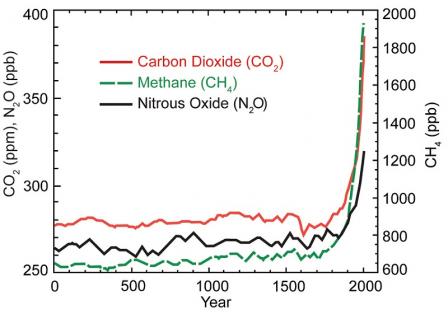There are human and physical causes of climate change.
- Enhanced Greenhouse Effect
This refers to the human influence on the greenhouse effect.

Since the Industrial Revolution began around 1750, humans have contributed to the warming of the planet by adding Co2 and other heat-trapping gases into the atmosphere. Human activities, such as the burning of fossil fuels and changes in land use, release large amounts of CO2, causing concentrations in the atmosphere to rise. Human activities currently release over 30 billion tons of CO2 into the atmosphere every year.
2. CFCs – Another group of greenhouse gases includes the chlorofluorocarbons (CFCs). CFCs have been responsible for depleting the ozone layer as they attack and destroy ozone molecules. The ozone layer helps keep out harmful ultraviolet rays that cause sunburn to skin and damage to plants. Holes in the ozone layer caused by CFCs, which can be found in aerosols, fridges and making foam plastics, let harmful ultraviolet radiation in and contribute to the greenhouse effect. Remember – CFCs do not occur naturally in the atmosphere – they are synthetic compounds that only originate from human sources.
3. Nitrous oxide from fertilizers– they are used in agriculture but also the burning of fossil fuels and organic matter. Remember nitrous oxide is a harmful greenhouse gas which traps heat in the atmosphere.
4. Methane – methane is much more potent than Co2 despite having a shorter lifespan. Human causes of methane release include decomposing organic matter (landfills, sewage) and from natural gas extraction (methane escapes during oil and gas extraction (e.g. fracking) operations and is released into the atmosphere).
5. Deforestation – trees are the lungs of the planet and store carbon.Forests in areas such as the Congo and the Amazon represent some of the world’s largest carbon stores on land. But when forests are logged or burnt, that carbon is released into the atmosphere, increasing the amount of carbon dioxide and other greenhouse gases and accelerating the rate of climate change. So much carbon is released that they contribute up to one-fifth of global man-made emissions, more than the world’s entire transport sector.





